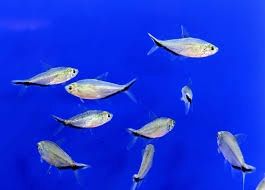Blackline Tail Costae Tetra
Blackline Tail Costae Tetra Care Guide
1. Tank Setup
-
Tank Size: The Blackline Tail Costae Tetra thrives in tanks of at least 38 liters (10 gallons), but a 76-liter (20 gallons) tank or larger will provide more space for swimming and reduce stress.
-
Aquascaping: They appreciate open swimming areas, but also need plants and decorations to feel secure. Include floating plants or plants along the tank's edges for shelter.
-
Substrate: A soft, fine gravel or sand substrate is ideal. Avoid sharp gravel to prevent injury to their barbels.
-
Water Temperature: Keep the water temperature between 22°C and 27°C (72°F to 80°F).
-
Water pH: These tetras prefer slightly acidic to neutral water, with a pH range of 6.0–7.0.
-
Filtration: Use a gentle filter. Tetras are sensitive to strong currents, so ensure the filter doesn’t create turbulent water.
2. Diet
-
Omnivores: Blackline Tail Costae Tetras will eat a variety of foods, including high-quality flakes, micro-pellets, and sinking foods.
-
They enjoy occasional live foods like brine shrimp, daphnia, bloodworms, and blackworms.
-
Feeding Frequency: Feed them small amounts 2–3 times a day. Be mindful of overfeeding, as these small fish can easily become bloated.
3. Tank Mates
-
Peaceful: These tetras are peaceful and do well with other small, non-aggressive fish. Good tankmates include other tetras, small rasboras, and Corydoras catfish.
-
Schooling Fish: They are schooling fish and should be kept in groups of 6–8 or more to help them feel secure and reduce stress.
-
Avoid Aggressive Species: Large or fin-nipping fish, like some cichlids or barbs, can stress out or injure the Blackline Tail Costae Tetra.
4. Behavior
-
Active & Peaceful: These tetras are active and curious. They swim in schools and prefer exploring the middle layers of the tank.
-
Shy at First: They may initially be shy in a new tank, so provide hiding spots using plants and decorations to make them feel safe.
-
Social Nature: They are more confident and active in groups. A school of these tetras creates a lively and dynamic display in your aquarium.
5. Health & Maintenance
-
Water Quality: Blackline Tail Costae Tetras are sensitive to poor water conditions. Maintain good water quality by regularly testing ammonia, nitrites, and nitrates. Perform 20-30% weekly water changes.
-
Common Illnesses: These tetras can be prone to diseases like Ich, Fin Rot, and Velvet. If you notice symptoms such as faded color or abnormal behavior, check the water quality and consider quarantining sick fish.
-
Stress: Stress is a common problem for tetras and often results from poor water conditions or aggressive tankmates. Keep the environment calm and stable.
6. Breeding
-
Breeding Setup: If you're interested in breeding, use a separate breeding tank with slightly cooler water (around 22°C–24°C or 72°F–75°F). Reduce the light levels to simulate natural spawning conditions.
-
Spawning: The Blackline Tail Costae Tetra is an egg-layer. After spawning, remove the parents as they may eat the eggs.
-
Fry Care: The eggs will hatch in 1–2 days. The fry will begin swimming after about 3–4 days. They will need very fine food like infusoria or liquid fry food until they are large enough to eat crushed flakes.
7. Lighting
-
Tetras prefer moderate to dim lighting. You can use floating plants or dense vegetation to reduce light intensity and mimic their natural habitat.
Final Thoughts:
The Blackline Tail Costae Tetra is a beautiful and peaceful fish that makes a great addition to a community tank. With proper care, these tetras will thrive, adding movement and color to your aquarium. Remember to keep them in groups, maintain stable water conditions, and provide plenty of swimming space and cover.

